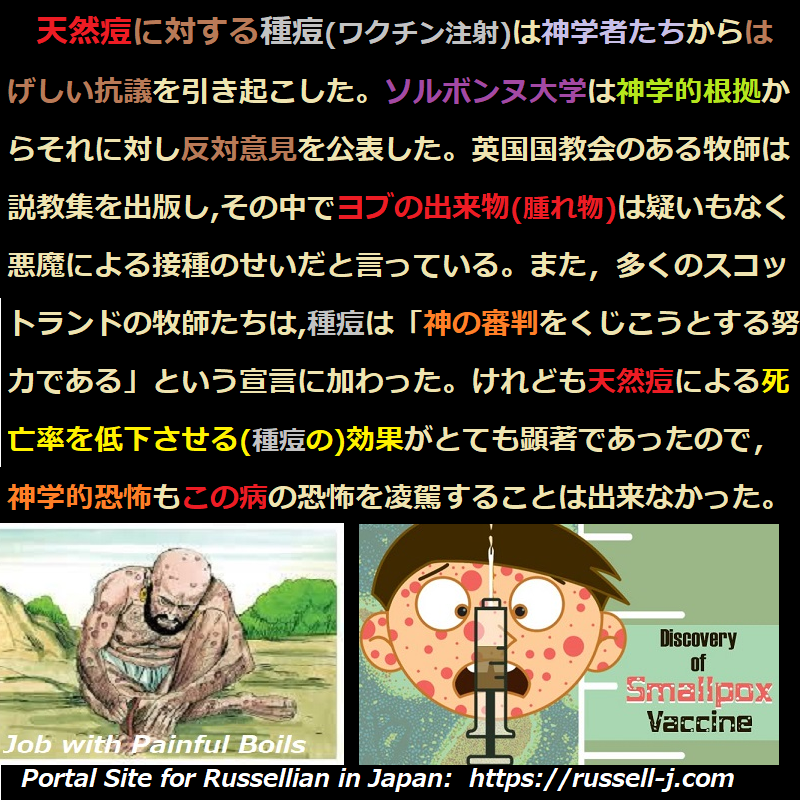
生理学は解剖学より遅れて発達し,血液循環の発見者ハーヴェー(William Harvey, 1578-1657:イングランドの解剖学者,医師。1628年に血液循環説を発表)ともに科学的になったと見てよいだろう(may be taken as)。彼はヴェサリウスと同様宮廷医(侍医) -最初はジェームズ一世の,その後チャールズ一世の- であったが,ヴュサリウスとは異なり,彼はチャールズ一世が亡くなった時でさえも迫害を受けなかった(注:when Charles I had fallen: 「fallen 亡くなった」を荒地出版社の訳本では「退位した時」と誤訳している)。その間の世紀(注:ヴェサリウスとハーベイとの間の期間)に,医学上の問題に関する意見は,ずっと自由になった。特にプロテスタント諸国においてそうであった。スペインの諸大学では,血液の循環は18世紀末においてさえ否定されており,また,解剖は(も)その時でもなお医学教育に加えられていなかった。 古い神学上の偏見は,かなり弱められたが,何らかの(何か)驚くほど新奇なもの(startling novelty)によって覚醒されると,再び現れた。天然痘に対する種痘(=天然痘の予防接種)(inoculation against smallpox)は,神学者たち(divines)からはげしい抗議を引き起こした(注:津田氏は divines を牧師たちと訳出)。ソルボンヌ大学は神学的根拠からそれに対し反対意見を公表した。英国国教会のある牧師は説教集を出版し,その中でヨブの出来物(腫れ物)(Job’s boils)は疑いもなく悪魔による接種のせいだと言っている。また,多くのスコットランドの牧師たち(ministers)は,種痘は「神の審判をくじこうとする努力である」という宣言(の発表)に加わった。けれども,(種痘の)天然痘による死亡率を低下させる効果(結果)がとても顕著であったので,神学的恐怖もこの病(天然痘)の恐怖を凌駕することは出来なかった。さらに,1768年には,エカチェリーナ2世(1729-1796)(注:ドイツ語のカザリン,英語のキャサリンの表記もあり)及び彼女の息子は種痘をうった。彼女は,もしかすると道徳的観点からではないかも知れないが,世俗的な(あの世ではなくこの世の)思慮分別が必要な問題における信蹟できる案内者と考えられた。 種痘の是非論に関する論争は消え始めていたが,予防接種(vaccination:ワクチン接種)の発見(注:予防接種が効果があることの発見)はその論争を復活させた(注:津田氏は vaccination 予防接種一般」を「種痘(天然痘に限定した予防接種)」と訳している)。聖職者たちは(また医者たちも),予防接種を「天(神)自体に,さらには,神の意にさえ反抗するもの」と見なした。ケンブリッジ大学においては,(ある)大学説教でも予防接種への反対が唱えられた(説教が行われた)。1885年になってさえも(そんなに時代が進んでも)モントリオールで天然痘が発生した時には,住民の内カトリック教徒たちは,牧師たちの支持の下に,予防接種に反対した。ある司祭(priest 神父)は次のように述べている。「もし,我々が天然痘にかかるとしたら,それは昨冬謝肉祭(注:カトリック教で行われる祭りで,四旬節(=復活祭前の四十日間)に肉を断つので、その直前三日ないし一週間をにぎやかに祝うもの)をやり,その時にごちそうを食べ肉体を喜ばせて主(神)を怒らせたからだ」。(また)「感染地区の中心にある修道院の神父たち(The Oblate Fathers)は予防接種を非難し続けた。(また)信者は,いろいろな種類の献身的な祈祷(devotional exercises 勤行/ごんぎょう)に頼るように熱心に勧められた。 全聖職団の裁可(the sanction of the hierarchy)のもと,聖母マリアへの厳粛な祈願をこめた聖歌大行列を行なうことが命ぜられ,ロザリオ(注:聖母マリアへの祈り「アヴェ・マリア」を繰り返し唱える際に用いる数珠状の祈りの用具)の使用も明細に指示された。」〈原注:ホワイト「前掲書」第2巻 p.60参照)
Chapter 4: Demonology and Medicine, n.18
Physiology developed later than anatomy, and may be taken as becoming scientific with Harvey (1578-1657), the discoverer of the circulation of the blood. Like Vesalius, he was a Court physician – first to James I and then to Charles I – but unlike Vesalius he suffered no persecution, even when Charles I had fallen. The intervening century had made opinion on medical subjects much more liberal, especially in Protestant countries. In Spanish universities, the circulation of the blood was still denied at the end of the eighteenth century, and dissection was still no part of medical education. The old theological prejudices, though much weakened, reappeared when awakened by any startling novelty. Inoculation against smallpox aroused a storm of protest from divines. The Sorbonne pronounced against it on theological grounds. One Anglican clergyman published a sermon in which he said that Job’s boils were doubtless due to inoculation by the Devil, and many Scottish ministers joined in a manifesto saying that it was “endeavouring to baffle a Divine judgment.” However, the effect in diminishing the death-rate from smallpox was so notable that theological terrors failed to outweigh fear of the disease. Moreover, in 1768 the Empress Catherine had herself and her son inoculated, and though perhaps not a model from an ethical point of view, she was considered a safe guide in matters of worldly prudence. The controversy had begun to die down when the discovery of vaccination revived it. Clergymen (and medical men) regarded vaccination as “bidding defiance to Heaven itself, even to the will of God” ; in Cambridge, a university sermon was preached against it. So late as 1885, when there was a severe outbreak of smallpox in Montreal, the Catholic part of the population resisted vaccination, with the support of their clergy. One priest stated : “If we are afflicted with smallpox, it is because we had a carnival last winter, feasting the flesh, which has offended the Lord.” “The Oblate Fathers, whose church was situated in the very heart of the infected district, continued to denounce vaccination ; the faithful were exhorted to rely on devotional exercises of various sorts ; under the sanction of the hierarchy a great procession was ordered with a solemn appeal to the Virgin, and the use of the rosary was carefully specified.”(note: White, op. cit., Vol. II, p. 60. )
出典:Religion and Science, 1935, chapt. 4:
情報源:https://russell-j.com/beginner/RS1935_04-180.HTM
